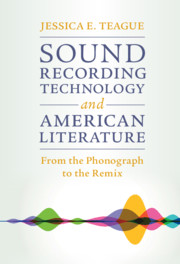Book contents
- Sound Recording Technology and American Literature
- Cambridge studies in American Literature and Culture
- Sound Recording Technology and American Literature
- Copyright page
- Dedication
- Contents
- Figures
- Acknowledgments
- Introduction Resonant Reading
- Chapter 1 Ears Taut to Hear
- Chapter 2 Ethnographic Transcription and the Jazz Auto/Biography
- Chapter 3 Press Play
- Chapter 4 The Stereophonic Poetics ofLangston Hughes and Amiri Baraka
- Chapter 5 From Cut-up to Mashup
- A Post-Electric Postscript Recording and Remix Onstage
- Notes
- Works Cited
- Index
- Recent Books In This Series (continued from page ii)
Introduction - Resonant Reading
Listening to American Literature after the Phonograph
Published online by Cambridge University Press: 07 May 2021
- Sound Recording Technology and American Literature
- Cambridge studies in American Literature and Culture
- Sound Recording Technology and American Literature
- Copyright page
- Dedication
- Contents
- Figures
- Acknowledgments
- Introduction Resonant Reading
- Chapter 1 Ears Taut to Hear
- Chapter 2 Ethnographic Transcription and the Jazz Auto/Biography
- Chapter 3 Press Play
- Chapter 4 The Stereophonic Poetics ofLangston Hughes and Amiri Baraka
- Chapter 5 From Cut-up to Mashup
- A Post-Electric Postscript Recording and Remix Onstage
- Notes
- Works Cited
- Index
- Recent Books In This Series (continued from page ii)
Summary
When Gertrude Stein published Three Lives, her first book-length work, in 1909, readers were struck by her peculiar, repetitive style. As one dust jacket review put it, Stein’s prose was like a “stubborn phonograph.” Taken in passing, the comparison might seem unremarkable, but in 1909, when the phonograph was still a relatively new technology, the dust jacket remark penned by Georgiana Goddard King (a Reader in English at Bryn Mawr College) reveals how at least one early reader heard Gertrude Stein. According to King, Stein had “pushed the method of realism as far as it would go,” and “the patient iteration, the odd style, with all its stops and starts, like a stubborn phonograph, are a part of the incantation. The reader must take it or leave it, – but always, taken or left, it remains astonishing.”
- Type
- Chapter
- Information
- Sound Recording Technology and American LiteratureFrom the Phonograph to the Remix, pp. 1 - 28Publisher: Cambridge University PressPrint publication year: 2021

